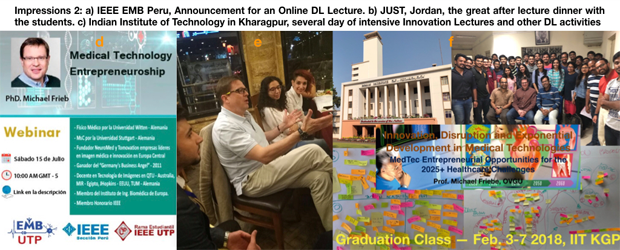I was actually talked into considering a position as an EMBS Distinguished Lecturer (DL) by one of my Indian graduate students, who believed that some of my entrepreneurial and innovation-oriented lectures would be of great value to the international community of biomedical engineering students. While the technical focus of my university chair role is image-guided therapies and minimal invasive therapies, I was prior to my academic career an entrepreneur for more than 20 years, the CEO of medium-sized medical device companies, and the founder of numerous start-ups in that field.
As part of the distinguished lecturer term I therefore planned to offer short, but country specific, lectures on “Medical Technology Innovation Generation and Entrepreneurship,” “Reverse Innovation and Exponential Technologies – Local Healthcare Solutions from INDIA / JORDAN / TURKEY / … for the world,” as well as longer and more intensive hands-on seminars on the same topic. Being too specific and dedicated in your lectures requires a very dedicated audience and I believed that my proposals would be more appealing and interesting to a larger crowd.
For everyone who considers becoming a Distinguished Lecturer (DL), it is a pro-bono (travel expenses more or less covered) engagement that takes quite a bit of time (if you are willing to take all the requests that are forwarded to you) but this opportunity also gives a lot back to the lecturer.
I will never forget the students’ enthusiasm and motivation combined with enormous gratitude. Today, I am still in contact with many of the professors and students of the sites that I visited and have also agreed to come back to several of the universities to continue the educational process with more intense seminars after my DL tenure. In addition, my institution is now engaged in joint research projects as well as hosting students with three of the universities visited, and the Australian institution even invited me to join their adjunct faculty as professor.

The first lecture led me to Istanbul, a three-hour flight from my home town. I managed to arrive in the late morning, give a one-hour lecture, have a late lunch with the hosts, and return the same day. So it is possible to do such an engagement as a quick trip, but not really recommended.
Typically a DL assignment extends over two calendar years. In my case I was asked to extend my DL term for another year, which I gladly agreed to. All in all, I gave talks/lectures/seminars in 16 different places (see above) totaling 30+ hours of talking time to more than 3,000 students, with roughly 125,000km travelled over five continents. Additionally, there were inquiries from another 15 institutions that I could not complete due to timing issues.
Adding the travel days and local lecture days, I roughly invested about one day per month over my 36-month tenure. This is obviously the major challenge —actually having enough time and the willingness to fly to exotic places on a relatively short notice. Some of the inquiries came only three weeks before an actual presentation mainly due to financing reasons between a local IEEE chapter and the head office (co-financing by the local organization has to be provided). This process likely can be improved, and with prior notice of three months or more many additional lectures could probably be managed.
In virtually all trips I was treated with utmost respect and as a guest of honor who was introduced to the local chapter management, the university leadership, and even to the local research ministers. The shorter keynote lectures are exciting, especially when there are hundreds, or in the case of India, thousands of attendees listening.
Other highlights were the joint dinners and time with other DLs in the old town of Tunis, the enthusiasm of the Jordanian students in Irbid, the local travel in India, and the beautiful host cities. Most rewarding for me, however, were the longer lectures in India, Jordan, and Egypt that sometimes spanned several days, involving the students (and often the local professors) in active workshop-style seminars. I certainly enjoyed the time with the students after the lectures the most — the real reason for being a DL — understanding and realizing that one can motivate and guide students by simply dedicating lecture and personal time to them.
In addition, the live online video presentation — including live translation into Spanish — that I prepared for the IEEE EMBS in Peru required a lot of extra work from my side, but could also be a good idea for lectures at remote places.

It was a personal honor for me and I learned a lot about different cultures, different teaching and learning approaches, and also about myself, and with that can only recommend medical engineering leaders and educators to consider becoming a DL. I would wish and hope that the IEEE EMBS will be able to continue and maybe even extend the DL activities and dedicate more funds to this important educational task in the future.
Login to IEEE Pulse
Reset Password
Enter the username or e-mail you used in your profile. A password reset link will be sent to you by email.


